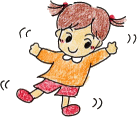All Ages
Clothing (All ages)
In Japan, it is thought that children should wear light clothing. This is so that they can feel and develop resistance to changes in temperature, strengthening their bodies and making it difficult for them to catch colds.
In principle, it is thought that children should wear one less layer of clothing than adults.



However, it may be difficult for children from other countries to adjust to Japan’s custom of wearing light clothing right away. Let your child adjust gradually.
■Indoors
- Spring and Fall:
Short-sleeved undershirt+thin long-sleeved shirt - Summer:
Short-sleeved shirt only (if cold, add an undershirt) - Winter:
Short-sleeved undershirt+long-sleeved shirt
■Outdoors
- Cardigan, vest, coat, socks
Tips
Even when wearing light clothing, it’s important to keep warm in winter! Without an undershirt, your child will get cold. Wearing a long undershirt will keep your child’s back and stomach warm.
Wearing multiple thin layers of clothing will keep your child warmer than wearing one heavy layer of clothing. Multiple layers also make it easier for your child to take off a layer if they are too warm or add a layer if they are cold.
- Birth-one month
Babies from birth to one month cannot yet regulate their body temperature well and should wear one more layer than adults. - One month-three months
Babies from one to three months begin to move their arms and legs more and should wear the same number of layers as adults. - Four months+
At four months, babies become more and more active and should wear one fewer layers than adults. - One year+
Choose separate tops and bottoms that allow for easy movement and are easy to put on and take off. - Two years+
Choose clothes that your child can put on and take off by their self.
What kind of fabric should I look for?
100% cotton is recommended for layers that touch the skin directly, since it is breathable and absorbent.
- On days when the temperature varies greatly or when your child will be exercising a lot and sweating, change their clothes often to keep them comfortable.
- Long underwear restricts your child’s movement, so it’s alright not to wear it.
- In summer, sleeved shirts are recommended as they will absorb sweat from your child’s back and armpits.
 It’s alright not to wear socks indoors. Modern homes retain heat and are
warm, and socks restrict your child’s movement and make it easier for them
to slip and fall indoors.
It’s alright not to wear socks indoors. Modern homes retain heat and are
warm, and socks restrict your child’s movement and make it easier for them
to slip and fall indoors.
Tips for choosing clothing
- Clothes should not be too tight.
Tight clothing restricts your child’s movement. - Choose clothes in your child’s size.
Children outgrow their clothes quickly, so you may be tempted to buy larger sizes. However, oversized clothes can be dangerous as your child may trip on the hems and fall. If you buy oversized clothes, be sure to hem them. - Choose clothes without too many ribbons or laces.
If your child is unable to tie them on their own, they may get caught on things and can pose a danger to them. - Avoid clothes with decorations that restrict your child’s movement.
Clothes with simple designs that are easy to move in are appropriate for active children. - Choose clothes that your child can put on and take off their self.
Clothes with many buttons or clothes that fasten in the back can be difficult for children to put on and take off. - Pay attention to fabrics and seams.
Clothing with less irritants are appropriate for children with sensitive skin.
